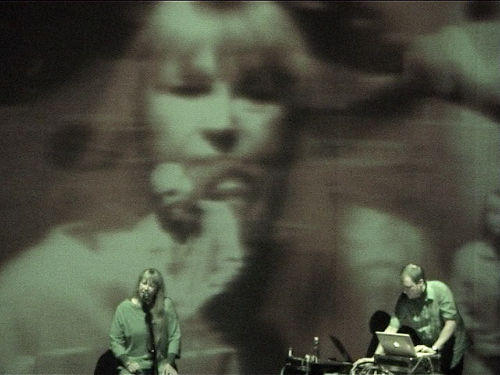
Last week I was in Budapest for the first time, a fantastic city!
I was invited to take part of a Touch – Punkt event as part of the Temps d´Images festival. The Touch label came with Mike Harding and Jon Wozencroft which gave a short seminar, and with the artists BJNilsen(laptop) and Hildur Ingveldardóttir Gudnadóttir (cello).
The concept of Punkt, which is a festival in Kristiansand run by Erik Honoré and Jan Bang is to sample a concert as it is being played, and using that sampled material as the basis of their own concert following straight after. They had invited Sidsel Endresen to join them on vocals, and Andras Halmos from Trafó had invited me to create the visual part of the concert.
I wanted to stick to the concept of using the first concert of BJNilsen and Gudnadóttir as the departure point for my video.

I created a very long image buffer, 12000×480 pixels. For recording, I could move sideways through the buffer and add images into the buffer, and eventually adding layers of overlapping images as the two concerts progressed. The image above is a small sample of what the buffer looked like at the end of the concert. For playback I had a very slow horisontal movement, so it would take several minutes to move through the buffer.
I wanted the recording head to move faster than the playback head so the images wouldn´t appear in a chronological order, and which also created some interesting layers of time.
Unfortunately I still don´t have any good images from the concert, the one at the top of the post is taken from my video camera with nightshot on, but you get an idea of the scale, it was a huge image behind the performers.
I was also supposed to do an hour presentation at Kitchen Budapest for maybe 10-15 people, but they convinced me to participate in a tech-pecha kucha event (so 20 slides, each showing for 20 seconds= 6min 40 sec) at the Merlin Theater with 300-400 people in the audience, so that was a strange but interesting experience. My impression was that people were sincerely interested in the content, my previous experiences with pecha kucha events has had a strong focus on entertaining, but superficial presentations.
By a weird coincidence one of the other presenters was Maté Gaspar from the theatre company Krétakör (website in hungarian) who I had been in touch with a year ago, so I got to visit their amazing workspace.
I also got a short tour of the Kitchen Budapest facilities, and finally met Adam Somlai-Fischer, who was supposed to be part of my seminar last fall.






